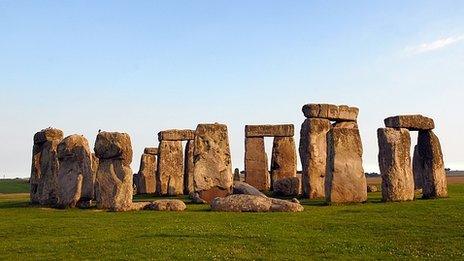Neolithic acoustics of Stonehenge revealed by academics
- Published

The degradation of the site meant it could not be used for acoustic tests
A team of academics have revealed the "sonic experience" that early visitors to Stonehenge would have heard.
Scholars from the Universities of Salford, Huddersfield and Bristol used an American replica of the monument to investigate its audio history.
Salford's Dr Bruno Fazenda said they had found the site reacted to sound "in a way that would have been noticeable to the Neolithic man".
He said the research would allow a "more holistic" view of its past.
The acoustic experiments could not be carried out at Stonehenge, as the derelict state of the site meant only a "few weak echoes and no noticeable reverberation" could be studied.
As a result, the team used a full-sized concrete reconstruction of it in Maryhill, America, which was built in 1929 as a memorial to WWI soldiers.
In February, scientist Steven Waller published a paper suggesting the design of Stonehenge could have been inspired by music.
Dr Fazenda, who has been involved with the acoustic testing of the monument for four years, said his own research had not revealed if this was the case or not.
"Stonehenge is very well known, but people are still trying to find out what it was built for," he said.
"We thought that doing this would bring an element of archaeology that so far hasn't been looked at.

The team used an American concrete replica of Stonehenge for tests
"This type of research is important because now we can not only see ourselves surrounded by the stones using virtual reality, but we can also listen how the stone structure would have enveloped people in a sonic experience.
"It is as if we can travel back in time and experience the space in a more holistic way."
Dr Fazenda said that the data collected did not "unequivocally reveal" if the site was designed with acoustics in mind, like a Roman amphitheatre.
But he added that it did show "the space reacted to acoustic activity in a way that would have been noticeable to the Neolithic man".
- Published18 April 2012
- Published5 March 2012